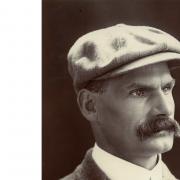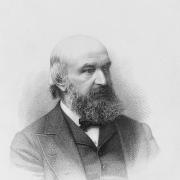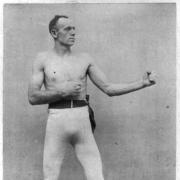A Cornish traveller of the early-19th century, explorer of West Africa and of the mighty Niger river, Richard Lander was captured and held for ransom by tribesmen, before dying on his third expedition aged just 29
Born in Truro at the Fighting Cocks Inn, later the Dolphin Inn, on February 8, 1804, Richard Lemon Lander (1804-34) was born the son of John Lander, an innkeeper in the city and handy wrestler, and educated at Old Pascoe’s in Truro’s Coombes Lane, which he departed in 1817. Apparently, he’d already walked to London aged just nine, simply because the young sprat thought the capital the place to be if he was going to see more of the world, an ambition he clearly held from a young age. Despite that stint at Old Pascoe’s it’s said that he had no formal education; but it was not to hold him back. If you’re wondering where his fruity middle name came from, well, I surmise it’s after the local mining bigwig and MP, Sir William Lemon, who was a Cornish MP when Richard was born.

After school he sailed for the West Indies with a merchant but contracted yellow fever and had to return home. It was just the first of several misadventures in Lander’s life. He’d then work in a slightly less trying employ as a servant to various wealthy families in London, and his wanderlust was satiated as he accompanied them on trips to Europe. His first visit to Africa, where he was to both make his name and lose his life, had seemingly come in 1823, when he visited the Cape of Good Hope, returning once again the following year.
In 1825, Lander and Captain Pearce R.N. accompanied the Scottish explorer and commander Lt. Hugh Clapperton (1788-1827), who’d previously crossed the Sahara, to Sokoto, in today’s Northern Nigeria, where Clapperton perished, worn down by the exigencies of the expedition and detention by the Sultan. Lander, who suffered bouts of illness himself, would survive an accusation of witchcraft from tribesmen and a ritualistic drinking of poison to prove his innocence, and somehow end as the last man standing among the Europeans on the mission, making it home in July 1828. Lander then published an account of the expedition, The Records of Clapperton’s Last Expedition, which had set off from the Gulf of Guinea and attempted to trace the course of the Niger, Lander having salvaged the journal of the expedition leader on which his account was based.
The British Government then commissioned Lander and his brother, printer and explorer John Lander (1807-39), who’d also been born in the Fighting Cocks, to research further the Lower Niger, so once again Richard landed in the Gulf of Guinea, at Badagri, before travelling inland to pick up the Niger at Bussa. In 1830 they were able to prove that the Niger descends by many mouths into the Bight of Benin, something they described in their ‘Journal’ (1832). They had actually explored upstream first for some 100 miles before beginning their journey downstream, which was an extremely hazardous trip by canoe but eventually they were able to reach the Niger’s delta mouth, establishing that it disgorged into the Atlantic. It was the first time anyone had traced the course of the Niger from Bussa to the sea, thereby solving the conundrum as to the great watercourse’s route and termination.
Their moment of triumph was somewhat overshadowed by their capture by Ibo tribesmen who cannily held them in lieu of a substantial ransom which was eventually paid. They finally reached Fernando Pó Island, no doubt mightily relieved. In 1832 Lander became the first winner of the Royal Geographical Society’s Founder’s Medal for his work on determining the course of the Niger.

During a third expedition of January 1834 Richard Lander returned to the Niger but was fatally wounded by Niger indigenes who attacked his canoe whilst he was on a trading mission and he duly died at Fernando Pó on February 6, 1834, just two days shy of his 30th birthday, courtesy of a musket ball wound. He was survived by his wife and daughter. A narrative of this particular journey was published by Laird and Oldfield in 1837, three years after Lander’s demise.
There’s a Richard Lander School in Truro whilst there’s also Lander’s Monument, a tall column by Cornish monumental sculptor Neville Northey Burnard (1818-78), which stands at the top of Lemon Street, and construction of which began in 1835 but may not have been finished until 1852. Given that Richard Lemon Lander’s monument is at the top of the street you could be forgiven for thinking that Lemon Street is named after the explorer, but you’d be wrong. Lemon Street is named after that local MP and mining magnate I mentioned earlier, Sir William Lemon (1748-1824).
Truro goes big on Lander as there’s also the Trelander housing estate which in Cornish denotes the home or town of Lander. Lander also left his mark in Africa where there’s a Truro Island in the Niger River. A hill on the riverbank was also dubbed Cornwall Mountain. There’s even a primary school there named in his honour. The Africans also had a name for Richard Lander; ‘Little Christian’.
What sort of qualities did Richard Lander possess? It seems entirely plausible that he was ambitious, possessed of high standards, confident, a natural-born leader and someone who wanted to make a positive contribution to the world in which he lived. These are the very virtues that Richard Lander School in Truro looks to encourage in its pupils.

CHRONOLOGY
1804 – Richard Lemon Lander born in Truro (February 8).
1813 – If reports are to be believed, the nine-year-old Lander walks to London.
1817 – Departs Old Pascoe’s school in Coombes Lane, Truro.
1818 – Returns home after contracting yellow fever on a trip to the West Indies.
1825 – The Clapperton expedition to the Niger. Lander is the only European survivor.
1830 – Richard Lander and his brother John solve the mystery of the Niger’s course.
1832 – First winner of the Royal Geographical Society’s Founder’s Medal.
1834 – Death of Richard Lander in Nigeria (February 6) aged 29.
1835 – Construction of Lander’s Monument in Truro begins.



























